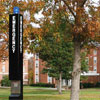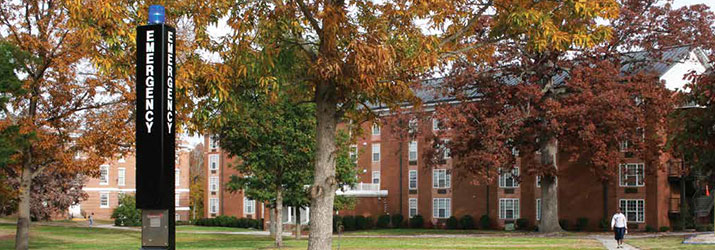
Glowing Blue Lights
Infrastructure on campus updates to new equipment
- By Samuel Shanes
- Apr 01, 2013

Colleges across the country have stepped up their safety and security
initiatives in the wake of recent mass shootings and tragedies.
Campuses large and small have re-worked their security infrastructure
and upgraded old and antiquated equipment. Louisburg
College, in Louisburg, N.C., has had great success with its
transition to an updated security infrastructure.
Over the past several years, Louisburg College has grown to nearly 700 students
and 150 employees. The college has 37 buildings, including seven residential facilities
spread across a large area. As the college steadily grew, there were discussions
about improving safety and security on campus. Jeffery Linney, the Louisburg
College chief of Campus Safety and Police, was charged with improving the campus’s
security systems and technology.
Several styles of call boxes and wall-mounted emergency phones were originally
installed at the college. Each unit was old and outdated, and the companies
who made them were no longer in business or had stopped making the phones.
Additionally, there was a lack of emergency phones in open and remote areas.
“We wanted to update our security infrastructure by updating our phones and
specifically adding towers,” Linney said. “We wanted one emergency phone tower
centrally located in a high-traffic area and multiple wall-mounted units added to
our three, newly-remodeled residence halls.”
After some research, Linney set up a meeting with Talk-A-Phone Co., to discuss
options.
“Talk-A-Phone came with their demonstration van and showed us some cool
things,” Linney said. “They set up a tower and set off an alarm that was very impressive.
We ended up going with them and were excited about the possibilities the
phones provided to enhance our capabilities on campus.”
After the phones were installed across campus, Linney quickly started to see
their effects.
“We had an activation yesterday,” Linney said. “Our officers were dispatched
and we were able to address the situation. There is no place we can’t be within a
minute or two if a callbox is activated. They make our job easier, and I think the
units have given the students an increased sense of security.”
The wall mounts and tower have been so well received by students and parents,
that the Louisburg admissions department has highlighted them during campus tours.
When a person in need activates a phone, they are connected immediately to
the campus police dispatch center. The exact location of the unit is provided to the
center, which saves time trying to figure out the location of the call. Alerts also are
sent to all campus law enforcement so the nearest officer can respond accordingly.
A large part of the emergency phones’ success has been their high visibility and
deterrent to crime. Each tower and wall mount is equipped with a blue LED light
that can be seen across campus. When a unit is activated, the light flashes until
assistance arrives.
“When I’m driving into work from home and I see that blue
light lit up, to me, that represents a safe campus,” Linney said.
“I’m sure it’s the same for parents and students. If they’ve been
to a lot of colleges, they know what these units represent.”
This article originally appeared in the April 2013 issue of Security Today.
About the Author
Samuel Shanes is the chairman of Talkaphone.